
Get a Free Quote
Tell us which service do you need so that our experts can help you create better quote

Famously known as the "City of Joy", Kolkata is a perfect blend of both historical and modern era. Kolkata is ever bustling with tourists and locals mainly for its book fairs, art exhibitions, concerts and the famous Durga Puja.
Once a capital of the British in India, the influence of the Britishers on Kolkata can still be experienced in its Victorian style architecture, trams and the cuisines. The city is also a famous destination for night owls with some amazing clubs, pubs and lounges that host cultural programs in the evenings for those who aren’t fans of loud music.
Whether you are visiting the majestic Howrah Bridge or exploring the various museums or making a stop at the religious Kali temple, all this can be made easier with our private cab that will make your one day trip to Kolkata even more memorable.
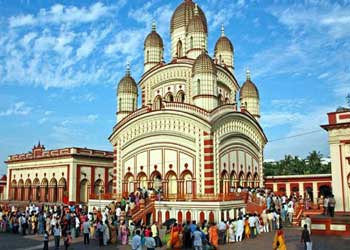 One of the most revered and famous temples of Kolkata, Dakshineswar Kali Temple is located in Dakshineswar village on the eastern bank of the Hooghly River. Built by Rani Rashmoni in 1855, this temple is the abode of Bhavatarini, an aspect of Kali.
One of the most revered and famous temples of Kolkata, Dakshineswar Kali Temple is located in Dakshineswar village on the eastern bank of the Hooghly River. Built by Rani Rashmoni in 1855, this temple is the abode of Bhavatarini, an aspect of Kali.
With an area of around 46 sq ft. and height of over 100 ft, Dakshineswar Kali Temple is an architectural wonder built in the traditional ‘Navaratna’ or nine spires style of Bengal architecture. This south facing three storeyed temple has nine spires distributed in the upper two storeys.
The sanctum sanctorum houses the idol of goddess Kali, known by the name of Bhavatarini, standing magnificently on the chest of supine Lord Shiva. These two idols are erected beautifully on a silver made thousand-petal lotus.
Apart from the main temple, there are twelve shrines dedicated to Lord Shiva along the riverfront, a temple dedicated to Radha and Krishna, a bathing ghat on the river, and a shrine dedicated to Rani Rashmoni. It also consists of a chamber in the northwestern corner where Sri Ramakrishna spent a considerable part of his life.
Must see: The Panchavati Garden consisting of five ancient trees is located quite near the temple. It is well maintained and beautifully landscaped where one can have a relaxed evening. It is also believed that Sri Ramakrishna used to meditate in this garden.
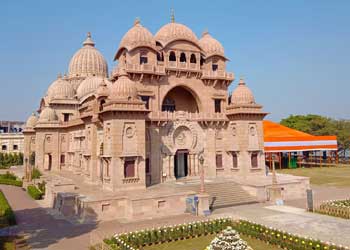 Located on the west bank of Hooghly River, Belur, the sprawling 40 acre land called as Belur Math is the next stop of our Kolkata day tour. Founded by Swami Vivekananda, the chief disciple of Ramakrishna Paramahamsa, Belur Math is the headquarters of the Ramakrishna Math and Mission.
Located on the west bank of Hooghly River, Belur, the sprawling 40 acre land called as Belur Math is the next stop of our Kolkata day tour. Founded by Swami Vivekananda, the chief disciple of Ramakrishna Paramahamsa, Belur Math is the headquarters of the Ramakrishna Math and Mission.
Apart from being a popular place of worship visited by people irrespective of their religion, Belur Math is also frequented by non religious people as it offers tranquillity and serenity that gives peace to the soul. It is quite famous for its architecture that blends the Christian, Islamic, Hindu and Buddhist art motifs as a symbol of unity.
Belur Math is the heart of the Ramakrishna Movement and is considered as a famous tourist spot in Kolkata. Ex-president Late APJ Abdul Kalam considered it as a “place of heritage and national importance.” The campus also houses a museum that consists of articles related to Ramakrishna Math and Mission.
The vast area of Belur Math also includes temples dedicated to Ramakrishna, Sarada Devi and Swami Vivekananda along with the main monastery of the Ramakrishna Order. The Ramakrishna temple is considered as an epitome of unity in diversity which is evident in its architecture as it resembles a temple, a mosque, and a church as seen from different positions.
Belur Math conducts various activities such as offering medical services, education and work for women and backward classes along with various relief, spiritual and cultural activities. The annual birthdays of Sri Ramakrishna, Vivekananda, Sarada Devi are also celebrated here along with the annual celebrations of Kumari Puja and Durga Puja that are conducted with much fervor.
Must See: The evening aarti at 5:30 pm daily is worth a watch during which the devotees are expected to meditate peacefully while hymns are chanted by the monks. Flower and sweet offerings during the aarti is not appreciated unlike in other temples.
 Next stop in the one day Kolkata tour is not a regular sightseeing place but a holy place where Mother Teresa lived and offered selfless services to humankind and ultimately found her resting place at this very site.
Next stop in the one day Kolkata tour is not a regular sightseeing place but a holy place where Mother Teresa lived and offered selfless services to humankind and ultimately found her resting place at this very site.
The Missionaries of Charity is a Roman Catholic religious congregation established by Mother Teresa in the year 1950. Over 4500 sisters work at the Mother House offering services to poor, aged, refugees, former prostitutes, mentally ill children, abandoned children as well as people suffering from diseases.
Missionaries also run schools to educate street children and have soup kitchens serving the needy. These services are provided free of cost irrespective of the people’s caste, creed or religion. The congregation has expanded to over 133 countries with various branches all over the world.
Mother House also houses a tomb where Mother Teresa was laid to rest and a huge number of people visit this tomb to pay their respect to the great human being. There is also a small museum by the side of the building known as ‘Mother Teresa’s Life, Spirit and Message’. It consists of belongings of Mother Teresa such as sandals, dinner-bowl, sari, etc. along with a few handwritten letters.
Must See: The Holy Mass is held every day at 6:00 AM in the Main Chapel. A special mass organised every Friday at 4:30 PM at Mother’s Tomb is not to be missed.
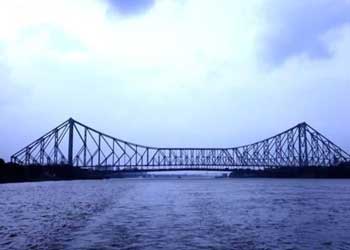 Howrah Bridge is synonymous with Kolkata and the next stop in our one day Kolkata tour. Built in 1935 across the Hooghly river, Howrah Bridge connects the twin cities of Howrah and Kolkata. Howrah Bridge was the third longest cantilever bridge at the time of its construction and now it is the sixth longest one.
Howrah Bridge is synonymous with Kolkata and the next stop in our one day Kolkata tour. Built in 1935 across the Hooghly river, Howrah Bridge connects the twin cities of Howrah and Kolkata. Howrah Bridge was the third longest cantilever bridge at the time of its construction and now it is the sixth longest one.
Howrah Bridge replaced the previous bridge known as the Pontoon Bridge, built at the same location. It was renamed as ‘Rabindra Setu’ after the great Bengali poet Rabindranath Tagore on 14 June 1965. With dimensions of 1500 ft over the Hooghly River and 71 ft wide, the bridge was built without the use of nuts or bolts and is held together by rivets.
Considered as one of the busiest cantilever bridges in the world, Howrah Bridge witnesses daily traffic of over 100,000 vehicles and more than 150,000 pedestrians. There is a total of 8 lanes with two footpaths on either side. There are also ferry services offered from Launch Ghat between Kolkata and Howrah that offers a breathtaking view of the Howrah Bridge, especially at night.
Howrah Bridge was constructed using about 26,500 tons of steel comprising of 23,000 tons of high-tensile alloy steel, known as Tiscrom. The main tower was constructed with single monolith caissons measuring 55.31 x 24.8 m. It has 21 shafts with each measuring around 6.25 metre square.
In popular culture, the iconic Howrah Bridge has featured in many movies like Do Bigha Zameen, China Town, Howrah Bridge, Amar Prem, Parineeta, The Namesake, Love Aaj Kal, Barfi, Kahaani, and Gunday to name a few.
Must see: A ferry ride during night time from one of the ghats is a must do activity to view the beauty of Howrah Bridge.
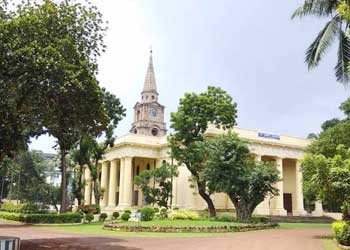 St. John’s Church is a historical site as part of the Kolkata local tour. It served as the Anglican Cathedral of Calcutta till St. Paul’s Cathedral took over in 1847. The foundation stone for the Church was laid by Warren Hastings, the then Governor General of India on 6 April 1784. He along with Chaplain William Johnson were the main people influential in building the church.
St. John’s Church is a historical site as part of the Kolkata local tour. It served as the Anglican Cathedral of Calcutta till St. Paul’s Cathedral took over in 1847. The foundation stone for the Church was laid by Warren Hastings, the then Governor General of India on 6 April 1784. He along with Chaplain William Johnson were the main people influential in building the church.
Built by architect James Agg, the church was built in Neoclassical architectural style that attracts its visitors with its unique features. The Church was built with a combination of brick and stone and hence is commonly referred as the “Pathure Girja” or the Stone Church. It is a square shaped structure with a 174 ft tall stone spire holding a giant clock.
St. John’s Church is built on a piece of land donated by Maharaja Nabo Kishen Bahadur, the founder of Sovabazar Raj Family. The land donated for the Church was an old burial ground where many important personalities like Job Charnock, the founder of Kolkata long with his family and Lady Canning, wife of the Governor-General and Viceroy of India, Charles Canning were buried.
With its beautiful stained glass windows, magnificent pillars, arches and domes, the Church is an architectural wonder. The Church displays beautiful paintings with interiors adorned with marble bass relief work and splendid wood carvings.
Must See: The Church premises has several memorials and tombstones of great historic importance that are worth a visit.
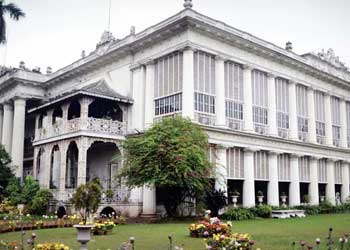 Next up in the Kolkata local tour is a palatial mansion built in the nineteenth century known as the Marble Palace. The magnificent palace which got its name due to the marble walls, floors and sculptures is a sight to behold. Built with superior quality Italian marble, this architectural wonder is one of the most beautifully conserved houses in the entire of Kolkata.
Next up in the Kolkata local tour is a palatial mansion built in the nineteenth century known as the Marble Palace. The magnificent palace which got its name due to the marble walls, floors and sculptures is a sight to behold. Built with superior quality Italian marble, this architectural wonder is one of the most beautifully conserved houses in the entire of Kolkata.
Marble Palace was built in 1835 by Raja Rajendra Mullick, a wealthy Bengali merchant who was also an art connoisseur. The palace has a splendid collection of western sculpture, pieces of Victorian furniture, paintings and antiques such as chandeliers, clocks, urns, etc. It has a beautiful collection of paintings from famous artists such as Ruben, Sir Joshua Reynolds, Titian, Murillo, and John Opie.
Marble Palace is built in Neoclassical style of architecture but the open courtyards of the palace are built in the traditional Bengali style. Adjacent to the courtyard, there is a place of worship known as thakur-dalan that is visited by the family members.
With tall fluted Corinthian pillars and balconies ornamented with admirable fretwork and sloping roofs, this three-storied building is built in the style of a Chinese pavilion. The palace is surrounded by a garden with lawns, a rock garden, a lake and a small zoo making it even more attractive.
Marble Palace is a private residence inherited by the descendants of Raja Rajendra Mullick Bahadur. Visiting this place requires special permission from the West Bengal Tourism Information Bureau at BBD Bag at least 24 hours in advance. Being a private residence, photography is not allowed inside the premises and the inhabited area is a restricted area.
Must See: The Marble Palace Zoo known as the first zoo opened in India by Raja Rajendra Mullick is located in the palace complex. It houses birds such as peacocks, hornbills, pelicans, storks, and cranes as well as monkeys and several species of deers.
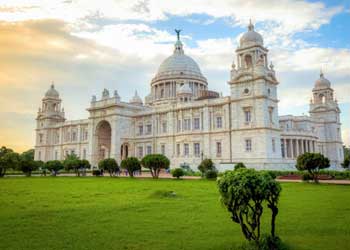 Representing the British influence in India, Victoria Memorial located in the heart of Kolkata city is our next stop in the one day local sightseeing tour of Kolkata. Built between 1906 and 1921, this white marble building was built in the memory of Queen Victoria to commemorate her 25 years of rule over India.
Representing the British influence in India, Victoria Memorial located in the heart of Kolkata city is our next stop in the one day local sightseeing tour of Kolkata. Built between 1906 and 1921, this white marble building was built in the memory of Queen Victoria to commemorate her 25 years of rule over India.
Lord Curzon, the then Viceroy of India, was the main person influential in building the memorial. He suggested constructing a grand building along with a museum and gardens for people to see and admire its beauty and grandeur. The Prince of Wales, later King George V, laid the foundation stone on 4 January 1906. The memorial was formally opened to the public in 1921.
Built in the Indo-Saracenic revivalist style of architecture, the memorial draws inspiration from Venetian, Egyptian, Deccani and Islamic styles as well. William Emerson, the then president of the Royal Institute of British Architects was the chief architect. With 184 feet height and dimensions of 338 feet by 228 feet, this magnificent monument was constructed using white Makrana marble.
There are a total of 25 galleries inside the memorial with the royal gallery, the sculpture gallery and the Calcutta gallery being the famous ones. Victoria memorial has a huge collection of marvellous paintings, with some of them dating back to the British era.
The Royal gallery houses the paintings by Jansen and Winter Halter depicting different life moments of Queen Victoria and her husband Prince Albert. The Calcutta gallery boasts of being the first city gallery of the country. It represents the development of the city from 17th century till 1911 when New Delhi replaced Calcutta as India’s capital.
Along with the galleries, the sprawling 64-acre garden displays a number of statues and sculptures. A bronze statue of Queen Victoria on a bronze throne at the entrance and other statues like those of Edward VII, Curzon, Hastings and Dalhousie can be found here. Along with these, symbolic sculptures like Motherhood, Architecture, Learning and Justice can also be seen here.
Must See: The Victoria Memorial Light and Sound Show called as Son-et-Lumiere held from October to June is worth a watch.
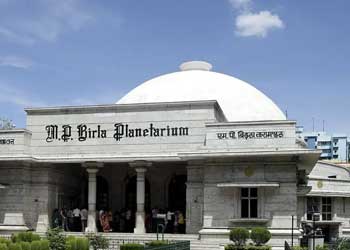 The last sightseeing place as part of the one day Kolkata local tour is Birla Planetarium, the largest of its kind in Asia and the second largest in the world. Inaugurated by Pandit Jawaharlal Nehru on 2nd July 1963, it is one of the three planetariums in India with the other two located in Chennai and Hyderabad.
The last sightseeing place as part of the one day Kolkata local tour is Birla Planetarium, the largest of its kind in Asia and the second largest in the world. Inaugurated by Pandit Jawaharlal Nehru on 2nd July 1963, it is one of the three planetariums in India with the other two located in Chennai and Hyderabad.
Built in the style of Sanchi Stupa, the planetarium consists of astronomical laboratories along with electronics and fabrication lab for building equipments. There is also an astronomy gallery that exhibits paintings and celestial models of famous astronomers.
Also known as Taramandal, the Planetarium has an astronomical observatory that is equipped with a Celestron C-14 Telescope alongwith accessories such as ST6 CCD camera and solar filter. With a total capacity of 6800, it offers more than 100 astronomical projects to the visitors.Must See: Daily shows are organised between 12 pm and 7 pm in various languages such as English, Hindi, Bengali and other regional languages. Do attend one of these informative shows.